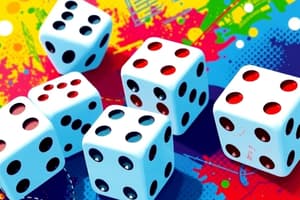Podcast
Questions and Answers
किस आंकड़े को प्राप्त करने की संभावना लगभग 16.67% है?
किस आंकड़े को प्राप्त करने की संभावना लगभग 16.67% है?
- 7
- 2
- 1 (correct)
- 6
यदि एक पैर के पास 7 के योग को प्राप्त करने की संभावना को निकालने के लिए हमें क्या करना चाहिए?
यदि एक पैर के पास 7 के योग को प्राप्त करने की संभावना को निकालने के लिए हमें क्या करना चाहिए?
- 6 से गुणा करके 7 से घटाकर
- सारे संभावित परिणामों की संख्या को जोड़कर 7 की संभावनाओं को बाँटकर (correct)
- सिर्फ 1 से जोड़कर
- सिर्फ 7 की संभावनाओं को जोड़कर
पेशी-पेशी संख्या प्राप्त करने की संभावना क्या है?
पेशी-पेशी संख्या प्राप्त करने की संभावना क्या है?
- 1/5
- 1/6 (correct)
- 1/4
- 1/12
पेशियों का महत्व क्या है?
पेशियों का महत्व क्या है?
किस उपकरण का उपयोग करके हमें अन्यत्र संभावनाओं और गहरी गणितीय अवधारणाओं को समझने का मौका मिलता है?
किस उपकरण का उपयोग करके हमें अन्यत्र संभावनाओं और गहरी गणितीय अवधारणाओं को समझने का मौका मिलता है?
किस गतिविधि के लिए पाशे का प्रयोग नहीं होता है?
किस गतिविधि के लिए पाशे का प्रयोग नहीं होता है?
पाशे का इतिहास किस समय से शुरू हुआ?
पाशे का इतिहास किस समय से शुरू हुआ?
किसके माध्यम से पाशे का नाम 'क्यूब' से आया?
किसके माध्यम से पाशे का नाम 'क्यूब' से आया?
किस प्रकार के प्रकरण में पाशों का प्रयोग होता है?
किस प्रकार के प्रकरण में पाशों का प्रयोग होता है?
किस प्रकार के पाशों का प्रारंभ में निर्माण किया गया था?
किस प्रकार के पाशों का प्रारंभ में निर्माण किया गया था?
Flashcards are hidden until you start studying
Study Notes
Dice: A Fascinating Tool for Understanding Probability
Dice, a small cube with six faces, has been a popular tool for games and entertainment for centuries. However, they are also used to teach probability, a branch of mathematics that deals with chance. In this article, we will explore the history of dice, their uses in games, and their role in understanding probability.
The History of Dice
Dice have a rich history that dates back to ancient times. They were used in various forms in different cultures, including the Greeks, Romans, and Egyptians. The word "dice" comes from the Greek word "dice," which means "cube." Dice were initially made of animal bones, but later, they were made of materials like ivory, wood, and metal.
Uses of Dice in Games
Dice are used in numerous games, both traditional and modern. Some popular games that use dice include:
- Craps: A casino game where players bet on the outcome of a series of rolls.
- Monopoly: A board game where players move around the board, buying and trading properties.
- Dungeons & Dragons: A role-playing game where players create characters and embark on adventures.
- Settlers of Catan: A strategy game where players build settlements and trade resources.
Dice and Probability
Probability, the branch of mathematics that deals with chance, can be studied using dice. Each face of a die has a specific number, and when a die is rolled, the probability of each number appearing is equal. So, the probability of rolling a 1 on a single roll is 1/6, or approximately 16.67%. Similarly, the probability of rolling a 2 is 1/6, and so on.
Dice can be used to understand more complex probabilities as well. For example, the probability of rolling a sum of 7 on a pair of dice can be calculated by adding up the probabilities of rolling each combination that adds up to 7 (1+6, 2+6, 3+6, 4+6, 5+6, 6+1) and dividing by the total number of possible outcomes (6x6=36).
Conclusion
Dice, a seemingly simple tool, has a rich history and a significant role in both games and probability. They have been used for entertainment and as a tool for teaching complex mathematical concepts. Understanding the probabilities associated with dice can be a fun and engaging way to learn about this important branch of mathematics.
Studying That Suits You
Use AI to generate personalized quizzes and flashcards to suit your learning preferences.




